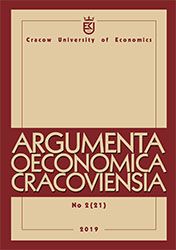Polish Commercial Banks’ Efficiency in 2009–2016 under Stress Conditions for Recapitalization
Polish Commercial Banks’ Efficiency in 2009–2016 under Stress Conditions for Recapitalization
Author(s): Piotr Karaś, Andrzej WalitzaSubject(s): Economy, Financial Markets
Published by: Wydawnictwo Uniwersytetu Ekonomicznego w Krakowie
Keywords: commercial banking; DEA; banking regulations; efficiency of bank operations
Summary/Abstract: In response to the outbreak of the global financial crisis, central banks and regulatory and supervisory bodies undertook a number of measures to mitigate the effects of the crisis and minimize its impact in the future. Changes were also made in Poland in 2009–2016, among others, in the areas of monetary policy (since 2015 interest rates have been at historically low levels), prudential regulations, the functioning of the deposit guarantee scheme, structured bankruptcy, and the so-called bank tax. The aim of this study is to attempt to answer the question of how changes in monetary policy and the regulatory environment affected the efficiency of banks in Poland. The study period was the years 2009–2016 and the sample consisted of the seventeen largest banks, divided into two groups. The division criterion was the value of the solvency ratio as a measure of a bank’s capital strength (the limit value adopted was the total capital ratio of 9%). Based on the research conducted, it can be argued that despite the fact that banks with lower capital ratios still achieve higher profitability on banking operations, better capitalized banks have significantly compensated for the gap by further improving the return on assets compared to less capitalized institutions.
Journal: Argumenta Oeconomica Cracoviensia
- Issue Year: 2/2019
- Issue No: 21
- Page Range: 149-163
- Page Count: 15
- Language: English

